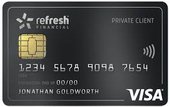Having a low income shouldn’t stop you from getting a credit card. In fact, more and more credit cards for low income households are becoming obtainable in Canada, and there are a ton of options out there. Some banks make it easy for people with low income to get credit cards. In fact, there are even credit cards for those with no income at all, allowing them to make necessary purchases. However, it’s important to know that income is never the only factor in qualifying for a credit card. Your credit history and credit score play an important part too.
How to know if you're a low income earner
According to the Canadian government's official poverty line – the Market Basket Measure (MBM) – a low household income lies somewhere between $37,000 p.a. and $50,000 p.a., depending on where you live.
But how does this translate into income requirements for credit cards? Some credit cards, such as American Express cards, don't have a specified income requirement, while others do, but the eligibility may be as low as $12,000 p.a. in some cases. In general terms, if your income is below $60,000 p.a., you'll probably be best served by a low income credit card. But you'll still have plenty of choices, including cards with rewards and complimentary benefits. However, low incomes will be generally ineligible for higher level cards with more attractive sign up bonuses like points and elevated cash back rates.
Why your income amount matters
There are three reasons why credit card issuers look at your income when you apply. The first is to make sure that you can afford to make repayments. The second is to help set your initial credit limit. And the third is to make sure that they make the maximum profit, since they're more likely to approve applications for premium cards from potential big spenders who will earn them plenty of merchant fees.
Why your income source mostly doesn't matter
While it is technically possible to get a credit card with no income, you'll probably stand a better chance of being approved if you do have an income source, no matter what it is. Your income could come from investments, a retirement fund, alimony, unemployment or disability benefits, or part-time or casual work. The card issuer is more interested in whether you can meet your repayment obligations than in how you receive your income.
Proving your income
The following ways of proving your income when applying for a credit card should be acceptable, depending on your income source:
- Pay stubs
- T4 statement of employment income
- T4E statement of unemployment benefit income
- T4A (P) statement of pension plan benefit (retirement, disability, etc.)
- A copy of your annual income tax return, and possibly a Notice of Assessment
- Proof of income statement (option C print) from the CRA
Alternatives to low income credit cards
If your income is so low that you are ineligible for a credit card, you still have options:
- Debit card. Debit cards are the most popular alternative to use because they let you spend only what you have and don’t come with an annual fee. They are linked directly to your bank account, so you never have to worry about being in debt because you're spending money you already have.
- Prepaid card. These can be used for purchases in the same way as credit and debit cards, but you preload them with a fixed amount of your own cash. When you have spent all the cash, you may have an option to reload more cash on to the same card. Like a debit card, there are no annual fees to pay, and no risk of getting over your head in debt.
- Secured credit card. Most credit card are unsecured, in that the card issuer does not require you to put up any collateral to secure the revolving line of credit it is extending to you. But if your income is too low, or your credit history poor or non-existent, you could opt for a secured credit card, where you deposit with the card issuer an amount of cash at least equivalent to the credit limit you are looking for. If you fail to meet your repayment obligations, the card issuer could use your deposit to pay off your card balance.
- Personal loan. Taking out a personal loan could be cheaper, especially if you can get a good interest rate. However, you need to be sure that you can afford repayments, as well as be aware of late fees, and early repayment that can also incur extra fees.
- Buy Now Pay Later. Many companies offer Buy Now Pay Later (BNPL) plans for various purchases such as appliances, furniture, electronics, fashion and services. With this type of plan, you can purchase something you need and then spread the interest-free repayments over a number of weeks to fit your budget. Fees are incurred for late payments. Popular BNPL services include PayBright, Sezzle, Afterpay, and Splitit.

